戴相林3,,,
刘国一1, 2,
谢永春2,
高小丽1, 4,
高雪1, 2
1.省部共建青稞和牦牛种质资源与遗传改良国家重点实验室 拉萨 850000
2.西藏自治区农牧科学院农业资源与环境研究所 拉萨 850000
3.河北省农林科学院滨海农业研究所 唐山 063299
4.西藏自治区农牧科学院农业研究所 拉萨 850000
基金项目:省部共建青稞和牦牛种质资源与遗传改良国家重点实验室自主课题(XZNKY-2020-C-007Z09)和西藏自治区自然科学基金项目(XZ2019ZRG-98)资助
详细信息
作者简介:马瑞萍, 研究方向为养分资源高效利用。E-mail: marp0825@126.com
通讯作者:戴相林, 主要研究方向为养分资源高效利用。E-mail: dxlok911@163.com
中图分类号:S154.3计量
文章访问数:95
HTML全文浏览量:30
PDF下载量:40
被引次数:0
出版历程
收稿日期:2021-03-12
录用日期:2021-04-28
网络出版日期:2021-08-13
刊出日期:2021-10-01
Effects of fertilizer patterns on the potential nitrogen fixation rate and community structure of asymbiotic diazotroph in highland barley fields on the Tibetan Plateau
MA Ruiping1, 2,,DAI Xianglin3,,,
LIU Guoyi1, 2,
XIE Yongchun2,
GAO Xiaoli1, 4,
GAO Xue1, 2
1. State Key Laboratory of Hulless Barley and Yak Germplasm Resources and Genetic Improvement, Lhasa 850000, China
2. Institute of Resources and Environment, Tibet Academy of Agricultural and Animal Husbandry Sciences, Lhasa 850000, China
3. Institute of Coastal Agriculture, Hebei Academy of Agriculture and Forestry Sciences, Tangshan 063299, China
4. Institute of Agriculture Research, Tibet Academy of Agricultural and Animal Husbandry Sciences, Lhasa 850000, China
Funds:This study was supported by the State Key Laboratory of Hulless Barley and Yak Germplasm Resources and Genetic Improvement (XZNKY-2020-C-007Z09), and the Natural Science Foundation of Tibet Autonomous Region (XZ2019ZRG-98)
More Information
Corresponding author:E-mail: dxlok911@163.com
摘要
HTML全文
图
参考文献
相关文章
施引文献
资源附件
访问统计
摘要
摘要:自生固氮是陆地生态系统氮素的重要来源。本研究以位于西藏拉萨的肥料长期定位试验站为平台, 选取不施肥(CK)、单施化肥(F)、单施羊粪(M)、化肥配施羊粪(FM)和化肥配施秸秆(FS)5个处理, 于青稞收获期采集土样, 采用15N同位素标记、定量PCR和高通量测序技术, 分析不同施肥模式下土壤理化性质、固氮微生物丰度、群落结构和潜在固氮速率的变化规律, 以期为西藏高原青稞田制定科学合理的施肥策略, 保障西藏高原农业绿色发展提供科学依据。结果表明: 1)相比于CK和F处理, M、FM和FS处理可显著(P<0.05)提高土壤有机碳和全氮含量。FM处理下土壤铵态氮含量最高, 且显著高于其他施肥处理(P<0.05), 而M处理下土壤有机碳、全氮、硝态氮、有效磷和速效钾含量最高, 且显著高于其他施肥处理(P<0.05)。2)不同施肥处理下青稞田土壤潜在固氮速率为2.63~4.07 μg?kg?1?d?1。施肥会降低土壤潜在固氮速率, 增施有机肥(羊粪或秸秆)则加剧了抑制效应, 但羊粪的抑制效应小于秸秆, 土壤铵态氮含量是影响土壤潜在固氮速率的主要因子。3) M或FM处理可显著(P<0.05)提高nifH基因丰度, 而F或FS处理则相反, 土壤全氮含量是影响nifH基因丰度的关键因子。4)不同施肥模式显著改变了固氮微生物群落结构, 其群落结构相似性大致可以分为3类, 分别为CK、M以及施用化肥处理(F、FM和FS), 有效磷、pH和C/N是调控固氮微生物群落结构的关键因子。综上所述, 单施羊粪(M)处理是提高青稞田土壤肥力、增加固氮微生物丰度, 减少固氮速率下降幅度的最佳施肥模式。
关键词:施肥模式/
青稞农田/
自生固氮/
潜在固氮速率/
西藏高原
Abstract:Free-living nitrogen fixation (FLNF) by diazotrophs is an important nitrogen (N) source in terrestrial ecosystems and may reprensent a viable solution to environmental pollution caused by N over-fertilization. Studying the impact of different fertilizer regimes in highland barley fields on the diazotrophic community profiles and potential N fixation rates (PNFR) may provide scientific fertilization strategies and a theoretical basis for agricultural green development in the Tibetan Plateau. Here, quantitative PCR, high-throughput sequencing and 15N labeling methods were used to better understand the impact of different fertilizer regimes on the abundance and composition of diazotrophs as well as the potential N fixation rates in highland barley fields on the Tibetan Plateau. The experiment included five treatments: a control without fertilizer (CK); N, phosphorus (P) and potassium (K) mineral fertilzers (F); manure fertilizer (M); mineral NPK fertilizers plus manure (FM); and mineral NPK fertilizer plus straw (FS). The results showed that: 1) compared with the CK and F treatments, the M, FM and FS treatments significantly (P<0.05) increased the contents of soil organic carbon (C) and total N. Moreover, the ammonium nitrogen (NH4+-N) content was significantly (P<0.05) higher in the FM treatment than in the other treatments. The highest contents of organic C, total N, nitrate N (NO3?-N), available P and available K were observed in the M treatment, and their contents were significantly (P<0.05) higher than those in the other treatments. 2) The PNFR ranged from 2.63 to 4.07 μg?kg?1?d?1 under different fertilizer treatments. Fertilization, especially the application of organic fertilizers (sheep manure or straw), reduced the PNFR, and the inhibitory effect of straw on PNFR was higher than that of sheep manure. The soil NH4+-N content was the main factor affecting PNFR. 3) The M and FM treatments significantly (P<0.05) increased diazotrophic abundance, while the opposite was observed for the F and FS treatments. The total N content was the key factor affecting diazotrophic abundance. 4) Different fertilizer patterns significantly changed the diazotrophic composition, and the similarities in the diazotrophic compositions among different fertilizer regimes fell into three major categories: no fertilization (CK), organic fertilization (M), and chemical fertilization (F, FM, FS). Available P was the key factor regulating diazotrophic composition, followed by pH and C/N. In conclusion, the M treatment was the optimal fertilizer practice to improve soil fertility, increase diazotrophic abundance and reduce PNFR decline in highland barley fields on the Tibetan Plateau.
Key words:Fertilizer pattern/
Highland barley field/
Free-living N fixation/
Potential N fixation rate/
Tibetan Plateau
HTML全文
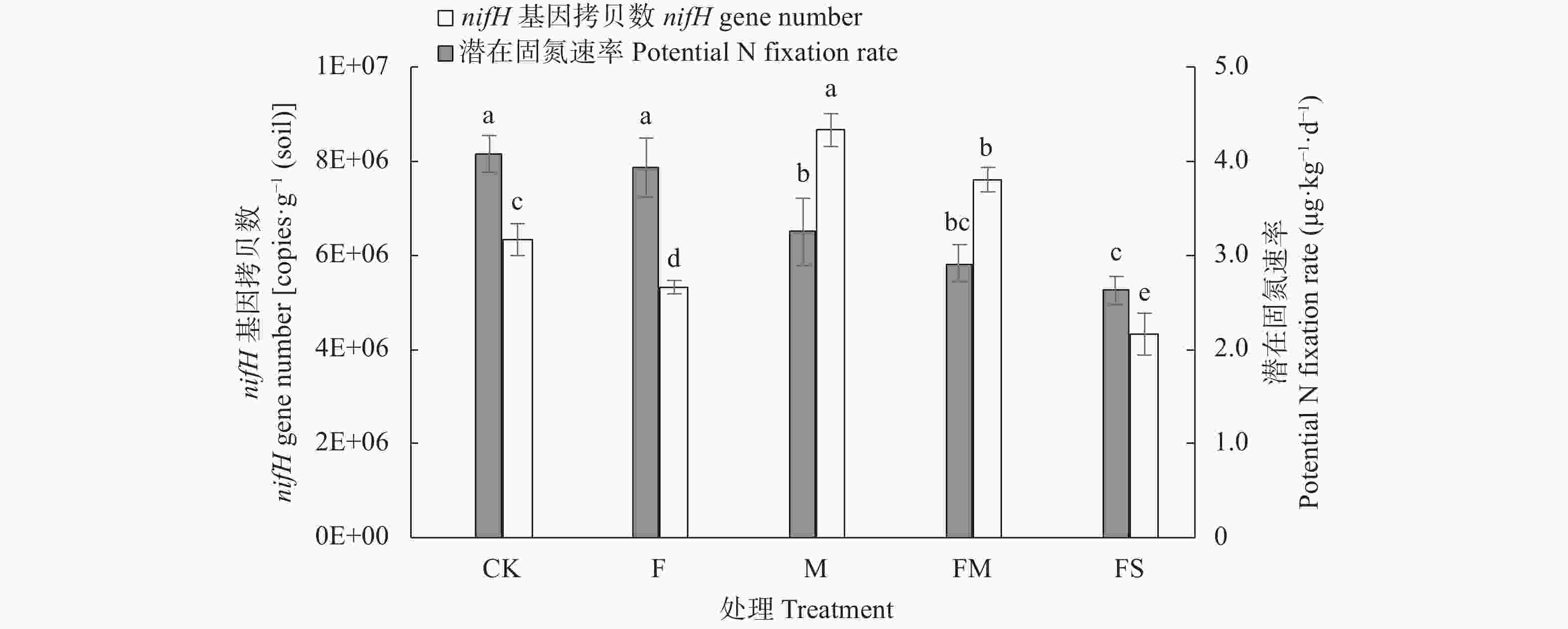
图1不同施肥模式下固氮微生物丰度和土壤潜在固氮速率的变化
CK: 不施肥; F: 施氮磷钾化肥; M: 单施羊粪; FM: 氮磷钾化肥+羊粪; FS: 氮磷钾化肥+秸秆。不同字母表示同一指标处理之间存在显著性差异(P<0.05)。CK: without fertilizer; F: only mineral NPK fertilizers; M: only sheep manure; FM: chemical NPK fertilizers plus sheep manure; FS: chemical NPK fertilizers plus barley straw. Different letters for the indicator indicate significant differences among fertilizer treatments at P<0.05 level.
Figure1.Changes of diazotrophic abundance and potential N fixation rate under different fertilizer regimes of hulless barley field
 下载: 全尺寸图片幻灯片
下载: 全尺寸图片幻灯片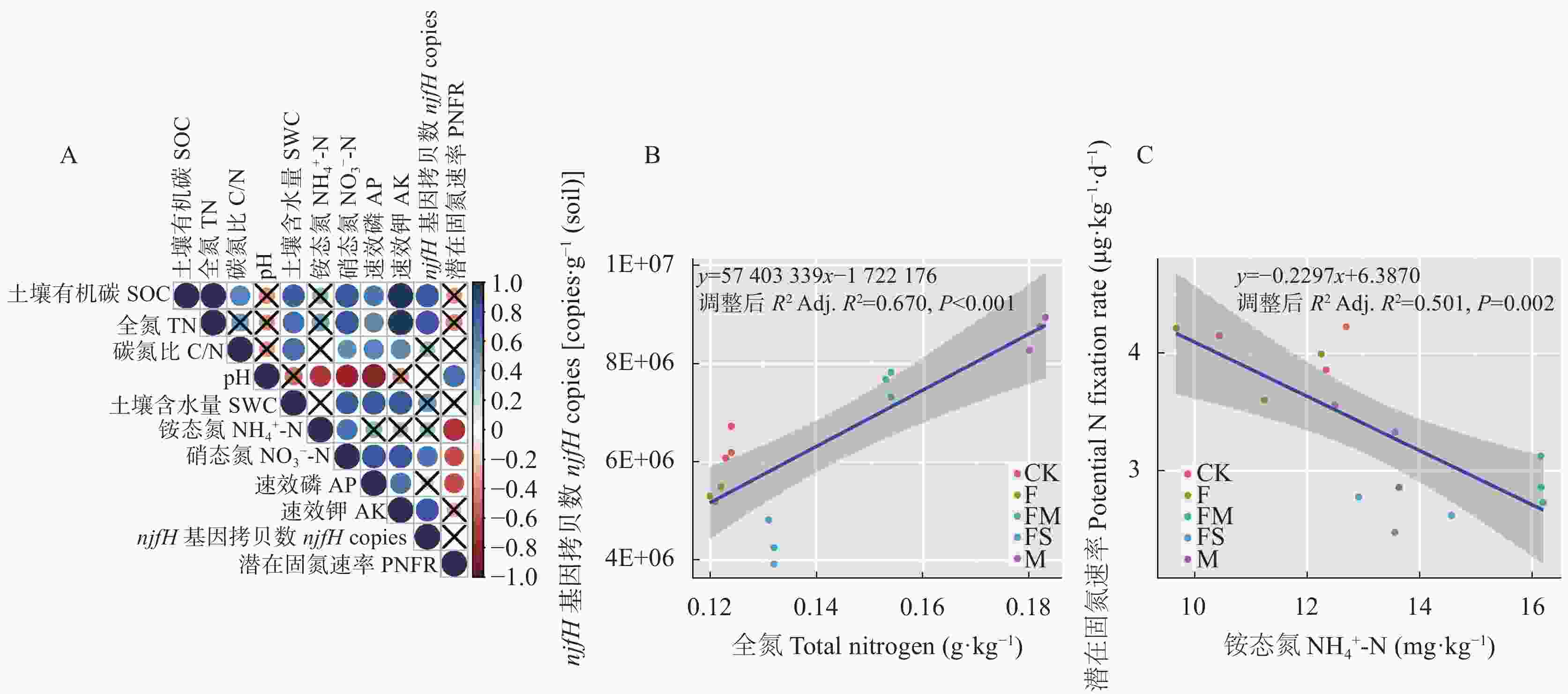
图2土壤理化性质与固氮微生物丰度和固氮潜势之间的关系
图A表示土壤理化性质与固氮微生物丰度和固氮潜势之间的Spearman相关性。其中蓝色和红色圆圈分别表示指标间的正相关和负相关, 圆圈大小表示指标间相关性的高低, “×”表示指标间相关性不显著。图B和图C分别为基于逐步回归分析揭示影响固氮微生物丰度和潜在固氮速率的关键土壤因子。其中, 蓝色线表示回归线, 灰色背景表示95%的置信区间。CK: 不施肥; F: 施氮磷钾化肥; M: 单施羊粪; FM: 氮磷钾化肥+羊粪; FS: 氮磷钾化肥+秸秆。Figure A shows the relationships among soil properties, diazotrophic abundance and potential N fixation rate (A) according to Spearman’s correlation coefficient, in which, blue and red circles denote positive and negative correlations, respectively, large to small circles indicate high to low correlations. “×” in circles means no significant correlaiton between indexes. SOC: soil organic carbon; TN: total nitrogen; SWC: soil water content; AP: available phosphorus; AK: available potassium; PNFR: potential N fixation rate. Figure B and C show the main predictors responsible for the changes in the diazotrophic abundance and PNFR based on stepwise linear regression analysis, respectively. The grey background indicates a 95% confidence interval. CK: without fertilizer; F: only mineral NPK fertilizers; M: only sheep manure; FM: chemical NPK fertilizers plus sheep manure; FS: chemical NPK fertilizers plus barley straw.
Figure2.Relationships among soil properties, diazotrophic abundance and potential N fixation rate
 下载: 全尺寸图片幻灯片
下载: 全尺寸图片幻灯片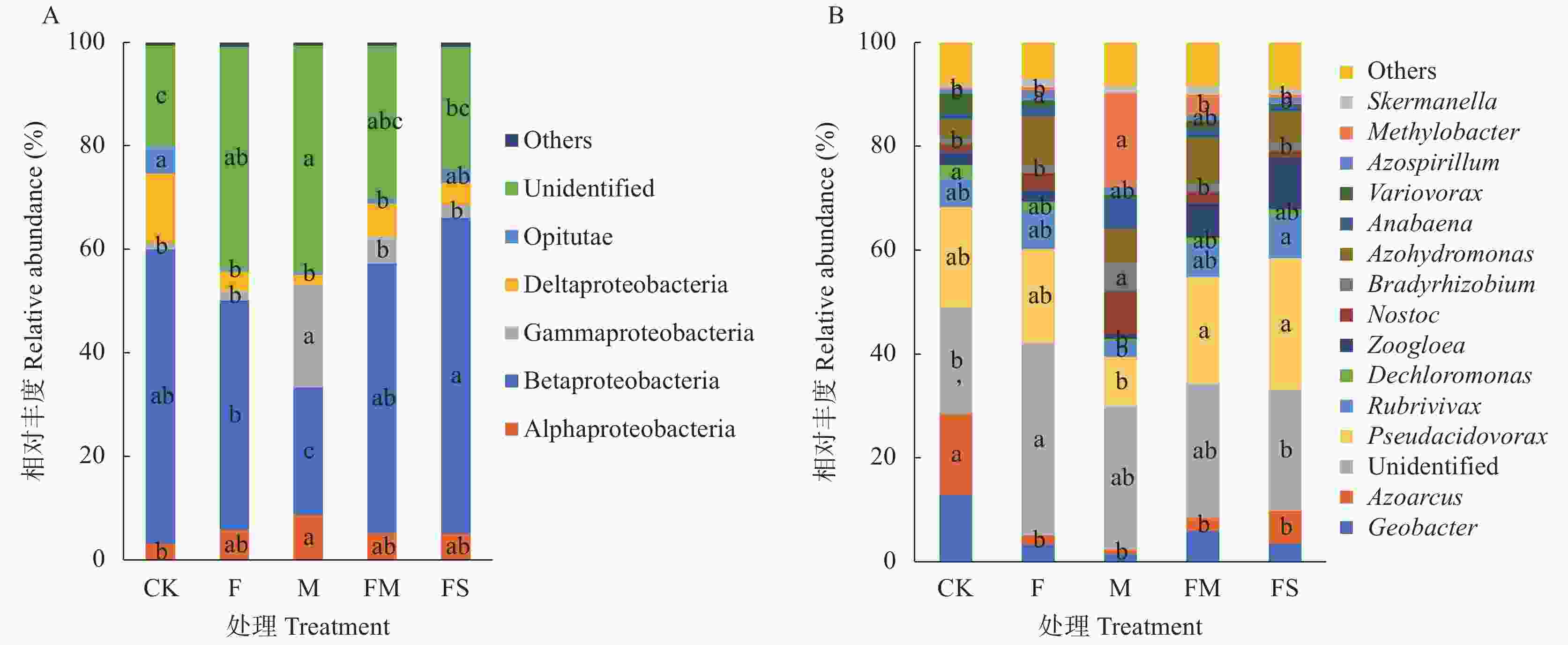
图3不同施肥模式下固氮微生物纲水平(A)和属水平(B)(相对丰度>1%)组成变化
CK: 不施肥; F: 施氮磷钾化肥; M: 单施羊粪; FM: 氮磷钾化肥+羊粪; FS: 氮磷钾化肥+秸秆。不同小写字母表示不同处理间差异显著(P<0.05)。柱体上无小写字母表示各处理间无显著差异。CK: without fertilizer; F: only mineral NPK fertilizers; M: only sheep manure; FM: chemical NPK fertilizers plus sheep manure; FS: chemical NPK fertilizers plus barley straw. Different lowercase letters indicate significant differences among treatments at P<0.05. No lowercase letters indicate significant differences among treatments at P>0.05.
Figure3.Changes of composition of diazotroph at the phylum (A) and genus (B) levels (relative abundance > 1%) under different fertilizer regimes
 下载: 全尺寸图片幻灯片
下载: 全尺寸图片幻灯片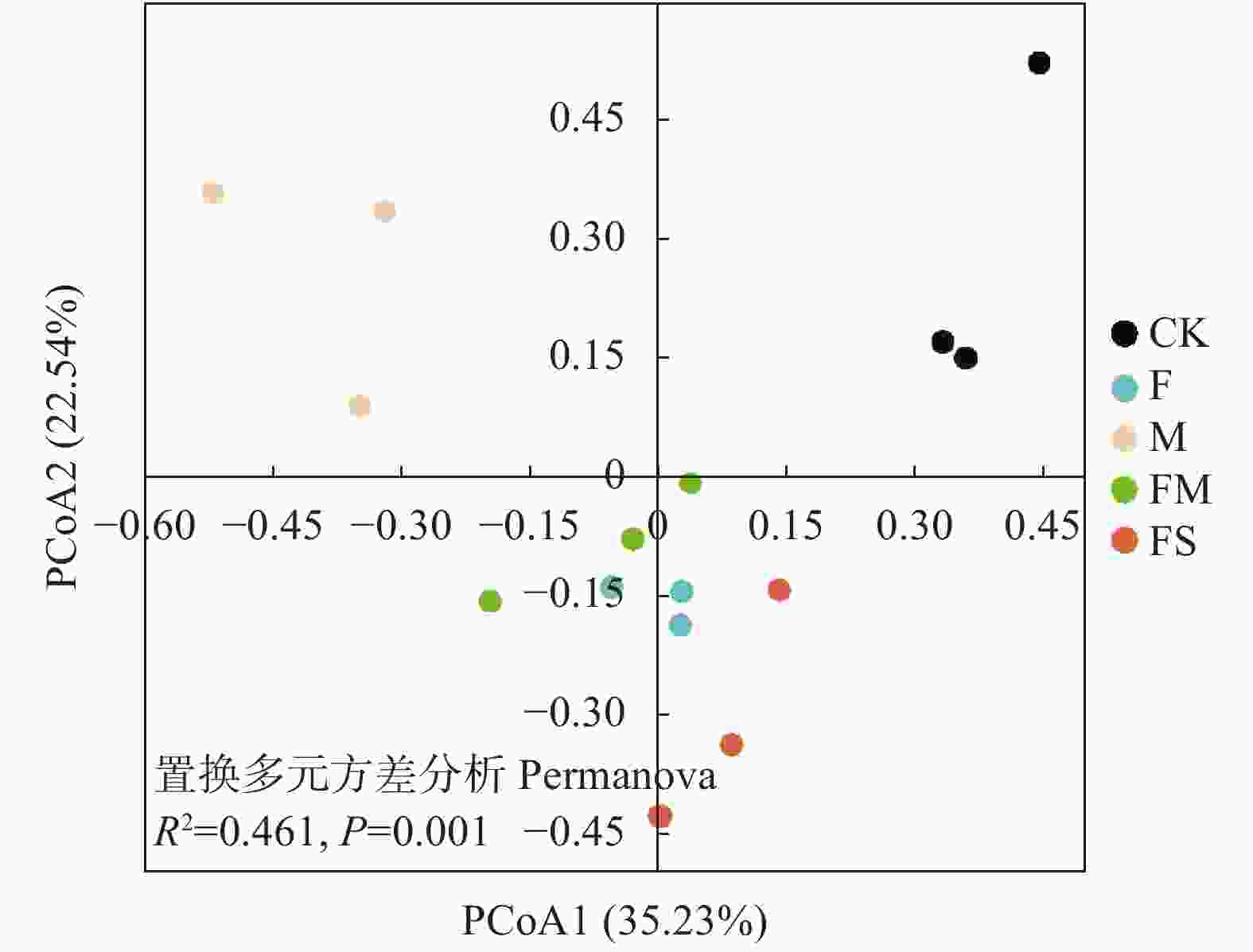
图4主坐标分析不同施肥模式对固氮微生物群落结构的影响
CK: 不施肥; F: 施氮磷钾化肥; M: 单施羊粪; FM: 氮磷钾化肥+羊粪; FS: 氮磷钾化肥+秸秆。CK: without fertilizer; F: only mineral NPK fertilizer; M: only sheep manure; FM: chemical NPK fertilizers plus sheep manure; FS: chemical NPK fertilizers plus barley straw.
Figure4.Principal coordinate analysis (PCoA) based on Bray-Curtis dissimilarity of diazotrophic communities under different fertilizer regimes
 下载: 全尺寸图片幻灯片
下载: 全尺寸图片幻灯片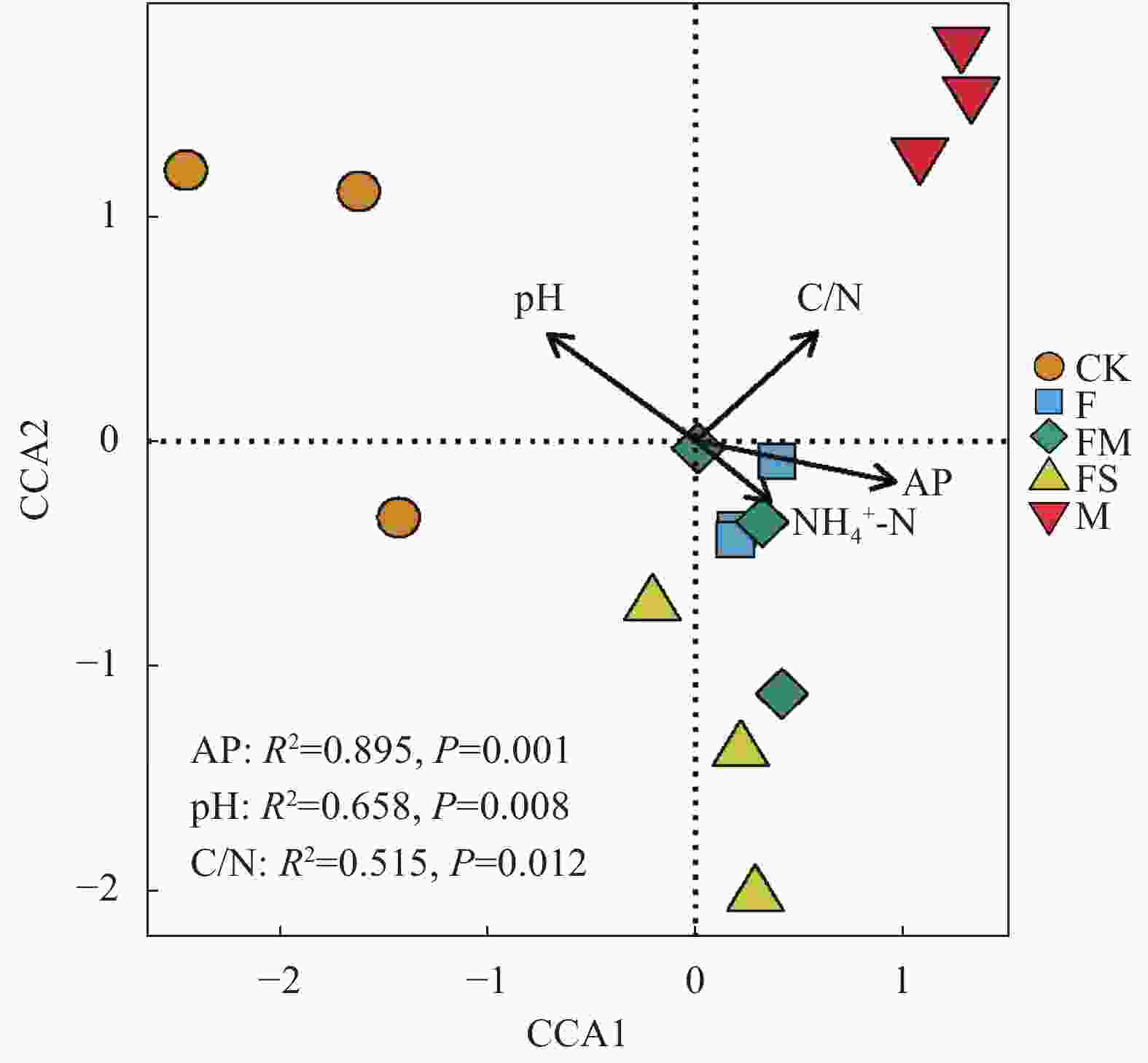
图5典范对应分析土壤理化因子(膨胀因子<10)与固氮微生物群落结构的关系
AP代表有效磷。CK: 不施肥; F: 施氮磷钾化肥; M: 单施羊粪; FM: 氮磷钾化肥+羊粪; FS: 氮磷钾化肥+秸秆。AP represents available phosphorus. CK: without fertilizer; F: only mineral NPK fertilizer; M: only sheep manure; FM: chemical NPK fertilizers plus sheep manure; FS: chemical NPK fertilizers plus barley straw.
Figure5.Relationship between soil properties (VIF<10) and diazotrophic communities based on canonical correlation analysis (CCA)
 下载: 全尺寸图片幻灯片
下载: 全尺寸图片幻灯片表1不同施肥模式下青稞田土壤理化性质的变化
Table1.Changes of soil physicochemical properties under different fertilizer regimes of hulless barley field
| 理化性质 Physicochemical property | CK | F | M | FM | FS |
| 有机碳 Organic carbon (g?kg?1) | 11.7±0.04d | 12.2±0.02d | 18.6±0.02a | 15.1±0.03b | 12.8±0.03c |
| 全氮 Total nitrogen (g?kg?1) | 1.24±0.00d | 1.21±0.00d | 1.82±0.00a | 1.54±0.00b | 1.32±0.00c |
| 碳氮比 C/N | 9.50±0.33c | 10.08±0.09ab | 10.22±0.15a | 9.86±0.26abc | 9.71±0.29bc |
| 土壤含水量 Water content (%) | 12.17±0.06e | 13.62±0.16b | 14.30±0.07a | 13.24±0.03c | 12.86±0.09d |
| pH | 8.44±0.02a | 8.25±0.01b | 8.25±0.01b | 8.10±0.02d | 8.20±0.02c |
| 铵态氮 NH4+-N (mg?kg?1) | 11.82±1.21cd | 11.05±1.30d | 13.22±0.64bc | 16.16±0.02a | 13.67±0.83b |
| 硝态氮 NO3?-N (mg?kg?1) | 1.88±0.15c | 3.30±0.16b | 5.00±0.50a | 4.97±0.17a | 3.28±0.08b |
| 有效磷 Available phosphorus (mg?kg?1) | 23.93±1.28d | 45.18±1.89bc | 49.65±2.34a | 48.02±1.24ab | 44.10±0.92c |
| 速效钾 Available potassium (mg?kg?1) | 65.17±1.75d | 74.35±2.67c | 120.71±5.87a | 92.33±4.75b | 72.84±1.31c |
| CK: 不施肥; F: 施氮磷钾化肥; M: 单施羊粪; FM: 氮磷钾化肥+羊粪; FS: 氮磷钾化肥+秸秆。同行不同字母表示处理之间存在显著性差异(P<0.05)。CK: without fertilizer; F: only mineral NPK fertilizers; M: only sheep manure; FM: chemical NPK fertilizers plus sheep manure; FS: chemical NPK fertilizers plus barley straw. Different letters in the same row indicate significant differences among fertilizer treatments at P<0.05 level. | |||||
 下载: 导出CSV
下载: 导出CSV表2土壤理化性质与固氮菌优势纲相对丰度之间的相关性分析
Table2.Spearman correlation between relative abundance of dominated class of diazotroph and soil physicochemical properties
| 纲 Class | 有机碳 Organic carbon | 全氮 Total nitrogen | 碳氮比 C/N | pH | 铵态氮 NH4+-N | 硝态氮 NO3?-N | 有效磷 Available phosphorus | 速效钾 Available potassium | 含水量 Water content |
| β-变形菌纲 Betaproteobacteria | ?0.483 | ?0.414 | ?0.811** | ?0.196 | 0.111 | ?0.484 | ?0.439 | ?0.554* | ?0.657** |
| α-变形菌纲 Alphaproteobacteria | 0.470 | 0.448 | 0.496 | ?0.174 | 0.121 | 0.559* | 0.371 | 0.568* | 0.607* |
| γ-变形菌纲 Gammaproteobacteria | 0.841** | 0.800** | 0.661** | ?0.326 | 0.429 | 0.751** | 0.789** | 0.882** | 0.671** |
| δ-变形菌纲 Deltaproteobacteria | ?0.329 | ?0.448 | ?0.193 | 0.149 | ?0.154 | ?0.504 | ?0.493 | ?0.525* | ?0.679** |
| 丰佑菌纲 Opitutae | ?0.459 | ?0.403 | ?0.559* | 0.148 | ?0.236 | ?0.583* | ?0.608* | ?0.652** | ?0.685** |
| *和**分别表示P<0.05和P<0.01水平显著相关。* and ** mean significant correlation at P<0.05 and P<0.01 levels, respectively. | |||||||||
 下载: 导出CSV
下载: 导出CSV表3土壤理化性质与固氮菌优势属相对丰度之间的相关性分析
Table3.Spearman correlation between relative abundance of dominated genera of diazotroph and soil physicochemical properties
| 属 Genus | 有机碳 Organic carbon | 全氮 Total nitrogen | 碳氮比 C/N | pH | 铵态氮 NH4+-N | 硝态氮 NO3?-N | 有效磷 Available phosphorus | 速效钾 Available potassium | 含水量 Water conten |
| 地杆菌属 Geobacter | ?0.360 | ?0.420 | ?0.186 | 0.106 | ?0.132 | ?0.468 | ?0.454 | ?0.493 | ?0.654** |
| 固氮弧菌属 Azoarcus | ?0.624* | ?0.577* | ?0.671** | 0.289 | ?0.189 | ?0.718** | ?0.707** | ?0.782** | ?0.896** |
| 假食酸菌属 Pseudacidovorax | ?0.528* | ?0.459 | ?0.782** | ?0.203 | 0.061 | ?0.500 | ?0.371 | ?0.504 | ?0.568* |
| 红长命菌属 Rubrivivax | ?0.308 | ?0.358 | ?0.250 | ?0.335 | ?0.107 | ?0.375 | ?0.246 | ?0.279 | ?0.357 |
| 脱氮单孢菌属 Dechloromonas | ?0.678** | ?0.711** | ?0.471 | 0.303 | ?0.432 | ?0.708** | ?0.454 | ?0.614 | ?0.582* |
| 动胶菌属 Zoogloea | ?0.335 | ?0.358 | ?0.564* | ?0.113 | 0.021 | ?0.340 | ?0.361 | ?0.464 | ?0.489 |
| 念珠藻属 Nostoc | 0.303 | 0.266 | 0.626* | 0.167 | ?0.097 | 0.418 | 0.429 | 0.500 | 0.695** |
| 慢生根瘤菌属 Bradyrhizobium | 0.556* | 0.560* | 0.511 | 0.018 | 0.154 | 0.624* | 0.411 | 0.596* | 0.554* |
| Azohydromonas | 0.156 | 0.078 | 0.375 | ?0.413 | 0.071 | 0.239 | 0.254 | 0.329 | 0.364 |
| 鱼腥藻属 Anabaena | 0.458 | 0.420 | 0.650** | ?0.011 | ?0.004 | 0.483 | 0.600* | 0.698** | 0.704** |
| 贪噬菌属 Variovorax | ?0.413 | ?0.325 | ?0.182 | 0.317 | ?0.157 | ?0.263 | ?0.250 | ?0.186 | ?0.254 |
| 固氮螺菌属 Azospirillum | 0.215 | 0.154 | 0.525* | ?0.031 | ?0.195 | 0.324 | 0.404 | 0.463 | 0.656** |
| 甲基细菌属 Methylobacter | 0.891** | 0.865** | 0.600** | ?0.425 | 0.500 | 0.842** | 0.879** | 0.918** | 0.768** |
| Skermanella | 0.345 | 0.319 | 0.407 | ?0.366 | 0.264 | 0.456 | 0.411 | 0.461 | 0.550* |
| *和**分别表示P<0.05和P<0.01水平显著相关。* and ** mean significant correlation at P<0.05 and P<0.01 levels, respectively. | |||||||||
 下载: 导出CSV
下载: 导出CSV参考文献
| [1] | 刘建国, 刘卫国. 微生物介导的氮循环过程研究进展[J]. 草地学报, 2018, 26(2): 277?283 LIU J G, LIU W G. Advances in microbial-mediated nitrogen cycling[J]. Acta Agrestia Sinica, 2018, 26(2): 277?283 |
| [2] | KENNEDY I R, ISIAM N. The current and potential contribution of asymbiotic nitrogen fixation to nitrogen requirements on farms: a review[J]. Australian Journal of Experimental Agriculture, 2001, 41(3): 447?457 doi: 10.1071/EA00081 |
| [3] | REED S C, CLEVELAND C C, TOWNSEND A R. Functional ecology of free-living nitrogen fixation: a contemporary perspective[J]. Annual Review of Ecology, Evolution, and Systematics, 2011, 42(1): 489?512 doi: 10.1146/annurev-ecolsys-102710-145034 |
| [4] | GUPTA V V S R, ROPER M M, ROGET D K. Potential for non-symbiotic N2-fixation in different agroecological zones of southern Australia[J]. Soil Research, 2006, 44(4): 343 doi: 10.1071/SR05122 |
| [5] | 孙建光, 徐晶, 胡海燕, 等. 中国十三省市土壤中非共生固氮微生物菌种资源研究[J]. 植物营养与肥料学报, 2009, 15(6): 1450?1465 doi: 10.3321/j.issn:1008-505X.2009.06.030 SUN J G, XU J, HU H Y, et al. Collection and investigation on asymbiotic nitrogen-fixing microbial resources from 13 provinces over China[J]. Plant Nutrition and Fertilizer Science, 2009, 15(6): 1450?1465 doi: 10.3321/j.issn:1008-505X.2009.06.030 |
| [6] | 徐鹏霞, 韩丽丽, 贺纪正, 等. 非共生生物固氮微生物分子生态学研究进展[J]. 应用生态学报, 2017, 28(10): 3440?3450 XU P X, HAN L L, HE J Z, et al. Research advance on molecular ecology of asymbiotic nitrogen fixation microbes[J]. Chinese Journal of Applied Ecology, 2017, 28(10): 3440?3450 |
| [7] | GABY J C, BUCKLEY D H. A global census of nitrogenase diversity[J]. Environmental Microbiology, 2011, 13(7): 1790?1799 doi: 10.1111/j.1462-2920.2011.02488.x |
| [8] | CHE R X, DENG Y C, WANG F, et al. Autotrophic and symbiotic diazotrophs dominate nitrogen-fixing communities in Tibetan grassland soils[J]. Science of the Total Environment, 2018, 639: 997?1006 doi: 10.1016/j.scitotenv.2018.05.238 |
| [9] | HAN L L, WANG Q, SHEN J P, et al. Multiple factors drive the abundance and diversity of the diazotrophic community in typical farmland soils of China[J]. FEMS Microbiology Ecology, 2019, 95(8): fiz113 doi: 10.1093/femsec/fiz113 |
| [10] | WANG C, ZHENG M M, SONG W F, et al. Impact of 25 years of inorganic fertilization on diazotrophic abundance and community structure in an acidic soil in Southern China[J]. Soil Biology and Biochemistry, 2017, 113: 240?249 doi: 10.1016/j.soilbio.2017.06.019 |
| [11] | WANG Q, WANG J L, LI Y Z, et al. Influence of nitrogen and phosphorus additions on N2-fixation activity, abundance, and composition of diazotrophic communities in a Chinese fir plantation[J]. Science of the Total Environment, 2018, 619/620: 1530?1537 doi: 10.1016/j.scitotenv.2017.10.064 |
| [12] | PEREZ P G, YE J, WANG S, et al. Analysis of the occurrence and activity of diazotrophic communities in organic and conventional horticultural soils[J]. Applied Soil Ecology, 2014, 79: 37?48 doi: 10.1016/j.apsoil.2014.03.006 |
| [13] | RAHAV E, GIANNETTO M J, BAR-ZEEV E. Contribution of mono and polysaccharides to heterotrophic N2 fixation at the eastern Mediterranean coastline[J]. Scientific Reports, 2016, 6: 27858 doi: 10.1038/srep27858 |
| [14] | HU X J, LIU J J, ZHU P, et al. Long-term manure addition reduces diversity and changes community structure of diazotrophs in a neutral black soil of northeast China[J]. Journal of Soils and Sediments, 2018, 18(5): 2053?2062 doi: 10.1007/s11368-018-1975-6 |
| [15] | IN Y X, YE G P, LIU D Y, et al. Long-term application of lime or pig manure rather than plant residues suppressed diazotroph abundance and diversity and altered community structure in an acidic Ultisol[J]. Soil Biology and Biochemistry, 2018, 123: 218?228 doi: 10.1016/j.soilbio.2018.05.018 |
| [16] | 方宇, 王飞, 贾宪波, 等. 绿肥配施减量化肥对土壤固氮菌群落的影响[J]. 农业环境科学学报, 2018, 37(9): 1933?1941 doi: 10.11654/jaes.2018-0509 FANG Y, WANG F, JIA X B, et al. Effect of green manure and reduced chemical fertilizer load on the community of soil nitrogen-fixing bacteria[J]. Journal of Agro-Environment Science, 2018, 37(9): 1933?1941 doi: 10.11654/jaes.2018-0509 |
| [17] | 王磊, 王静, 张爱君, 等. 小麦-甘薯轮作长期增施有机肥对碱性土壤固氮菌群落结构及多样性的影响[J]. 生态学报, 2020, 40(16): 5771?5782 WANG L, WANG J, ZHANG A J, et al. Effects of long-term organic fertilization on soil diazotrophic community structure and diversity under wheat-sweet potato rotation system[J]. Acta Ecologica Sinica, 2020, 40(16): 5771?5782 |
| [18] | FAN K K, DELGADO-BAQUERIZO M, GUO X S, et al. Suppressed N fixation and diazotrophs after four decades of fertilization[J]. Microbiome, 2019, 7(1): 143 doi: 10.1186/s40168-019-0757-8 |
| [19] | LIAO H K, LI Y Y, YAO H Y. Fertilization with inorganic and organic nutrients changes diazotroph community composition and N-fixation rates[J]. Journal of Soils and Sediments, 2018, 18(3): 1076?1086 doi: 10.1007/s11368-017-1836-8 |
| [20] | CAO Y S, HE Z L, ZHU T B, et al. Organic-C quality as a key driver of microbial nitrogen immobilization in soil: a meta-analysis[J]. Geoderma, 2021, 383: 114784 doi: 10.1016/j.geoderma.2020.114784 |
| [21] | NELSON D R, MELE P M. The impact of crop residue amendments and lime on microbial community structure and nitrogen-fixing bacteria in the wheat rhizosphere[J]. Soil Research, 2006, 44(4): 319 doi: 10.1071/SR06022 |
| [22] | TANG Y F, ZHANG M M, CHEN A L, et al. Impact of fertilization regimes on diazotroph community compositions and N2-fixation activity in paddy soil[J]. Agriculture, Ecosystems & Environment, 2017, 247: 1?8 |
| [23] | XIAO D, XIAO L M, CHE R X, et al. Phosphorus but not nitrogen addition significantly changes diazotroph diversity and community composition in typical Karst grassland soil[J]. Agriculture, Ecosystems & Environment, 2020, 301: 106987 |
| [24] | HSU S F, BUCKLEY D H. Evidence for the functional significance of diazotroph community structure in soil[J]. The ISME Journal, 2009, 3(1): 124?136 doi: 10.1038/ismej.2008.82 |
| [25] | STEWART K J, COXSON D, SICILIANO S D. Small-scale spatial patterns in N2-fixation and nutrient availability in an arctic hummock-hollow ecosystem[J]. Soil Biology and Biochemistry, 2011, 43(1): 133?140 doi: 10.1016/j.soilbio.2010.09.023 |
| [26] | 谢祖彬, 张燕辉, 王慧. 稻田生物固氮研究进展及方向[J]. 土壤学报, 2020, 57(3): 540?546 doi: 10.11766/trxb201912060662 XIE Z B, ZHANG Y H, WANG H. Advances and perspectives in paddy biological nitrogen fixation[J]. Acta Pedologica Sinica, 2020, 57(3): 540?546 doi: 10.11766/trxb201912060662 |
| [27] | 石元亮, 王玲莉, 刘世彬, 等. 中国化学肥料发展及其对农业的作用[J]. 土壤学报, 2008, 45(5): 852?864 doi: 10.3321/j.issn:0564-3929.2008.05.012 SHI Y L, WANG L L, LIU S B, et al. Development of chemical fertilizer industry and its effect on agriculture of China[J]. Acta Pedologica Sinica, 2008, 45(5): 852?864 doi: 10.3321/j.issn:0564-3929.2008.05.012 |
| [28] | 张福锁, 王激清, 张卫峰, 等. 中国主要粮食作物肥料利用率现状与提高途径[J]. 土壤学报, 2008, 45(5): 915?924 doi: 10.3321/j.issn:0564-3929.2008.05.018 ZHANG F S, WANG J Q, ZHANG W F, et al. Nutrient use efficiencies of major cereal crops in China and measures for improvement[J]. Acta Pedologica Sinica, 2008, 45(5): 915?924 doi: 10.3321/j.issn:0564-3929.2008.05.018 |
| [29] | 牛新胜, 巨晓棠. 我国有机肥料资源及利用[J]. 植物营养与肥料学报, 2017, 23(6): 1462?1479 doi: 10.11674/zwyf.17430 NIU X S, JU X T. Organic fertilizer resources and utilization in China[J]. Journal of Plant Nutrition and Fertilizer, 2017, 23(6): 1462?1479 doi: 10.11674/zwyf.17430 |
| [30] | ZHANG F S, CUI Z L, FAN M S, et al. Integrated soil-crop system management: reducing environmental risk while increasing crop productivity and improving nutrient use efficiency in China[J]. Journal of Environmental Quality, 2011, 40(4): 1051?1057 doi: 10.2134/jeq2010.0292 |
| [31] | 孙鸿烈, 郑度, 姚檀栋, 等. 青藏高原国家生态安全屏障保护与建设[J]. 地理学报, 2012, 67(1): 3?12 doi: 10.11821/xb201201001 SUN H L, ZHENG D, YAO T D, et al. Protection and construction of the national ecological security shelter zone on Tibetan Plateau[J]. Acta Geographica Sinica, 2012, 67(1): 3?12 doi: 10.11821/xb201201001 |
| [32] | 姚檀栋, 朱立平. 青藏高原环境变化对全球变化的响应及其适应对策[J]. 地球科学进展, 2006, 21(5): 459?464 doi: 10.3321/j.issn:1001-8166.2006.05.003 YAO T D, ZHU L P. The response of environmental changes on Tibetan Plateau to global changes and adaptation strategy[J]. Advances in Earth Science, 2006, 21(5): 459?464 doi: 10.3321/j.issn:1001-8166.2006.05.003 |
| [33] | 鲍士旦. 土壤农化分析[M]. 3版. 北京: 中国农业出版社, 2000 BAO S D. Soil Agricultural Chemical Analysis[M]. 3rd Edition. Beijing: China Agriculture Press, 2000 |
| [34] | RO?SCH C, MERGEL A, BOTHE H. Biodiversity of denitrifying and dinitrogen-fixing bacteria in an acid forest soil[J]. Applied and Environmental Microbiology, 2002, 68(8): 3818?3829 doi: 10.1128/AEM.68.8.3818-3829.2002 |
| [35] | POLY F, RANJARD L, NAZARET S, et al. Comparison of nifH gene pools in soils and soil microenvironments with contrasting properties[J]. Applied and Environmental Microbiology, 2001, 67(5): 2255?2262 doi: 10.1128/AEM.67.5.2255-2262.2001 |
| [36] | CHEN H, ZHENG C Y, QIAO Y Q, et al. Long-term organic and inorganic fertilization alters the diazotrophic abundance, community structure, and co-occurrence patterns in a vertisol[J]. Science of the Total Environment, 2021, 766: 142441 doi: 10.1016/j.scitotenv.2020.142441 |
| [37] | YANG L, BAI J S, ZENG N H, et al. Diazotroph abundance and community structure are reshaped by straw return and mineral fertilizer in rice-rice-green manure rotation[J]. Applied Soil Ecology, 2019, 136: 11?20 doi: 10.1016/j.apsoil.2018.12.015 |
| [38] | SUN R B, GUO X S, WANG D Z, et al. Effects of long-term application of chemical and organic fertilizers on the abundance of microbial communities involved in the nitrogen cycle[J]. Applied Soil Ecology, 2015, 95: 171?178 doi: 10.1016/j.apsoil.2015.06.010 |
| [39] | 张苗苗, 刘毅, 盛荣, 等. 稻草还田对水稻土固氮基因(nifH)组成结构和多样性的影响[J]. 应用生态学报, 2013, 24(8): 2339?2344 ZHANG M M, LIU Y, SHENG R, et al. Effects of rice straw returning on the community structure and diversity of nitrogen-fixing gene (nifH) in paddy soil[J]. Chinese Journal of Applied Ecology, 2013, 24(8): 2339?2344 |
| [40] | PETERS J W, FISHER K, DEAN D R. Nitrogenase structure and function: a biochemical-genetic perspective[J]. Annual Review of Microbiology, 1995, 49: 335?366 doi: 10.1146/annurev.mi.49.100195.002003 |
| [41] | 杨璐, 曾闹华, 白金顺, 等. 紫云英季土壤固氮微生物对外源碳氮投入的响应[J]. 中国农业科学, 2020, 53(1): 105?116 doi: 10.3864/j.issn.0578-1752.2020.01.010 YANG L, ZENG N H, BAI J S, et al. Responses of soil diazotroph community to rice straw, glucose and nitrogen addition during Chinese milk vetch growth[J]. Scientia Agricultura Sinica, 2020, 53(1): 105?116 doi: 10.3864/j.issn.0578-1752.2020.01.010 |
| [42] | FAN K K, WEISENHORN P, GILBERT J A, et al. Soil pH correlates with the co-occurrence and assemblage process of diazotrophic communities in rhizosphere and bulk soils of wheat fields[J]. Soil Biology and Biochemistry, 2018, 121: 185?192 doi: 10.1016/j.soilbio.2018.03.017 |
| [43] | XU L, ZHANG B C, WANG E T, et al. Soil total organic carbon/total nitrogen ratio as a key driver deterministically shapes diazotrophic community assemblages during the succession of biological soil crusts[J]. Soil Ecology Letters, 2021: 1?14 |
| [44] | COELHO M R R, MARRIEL I E, JENKINS S N, et al. Molecular detection and quantification of nifH gene sequences in the rhizosphere of Sorghum (Sorghum bicolor) sown with two levels of nitrogen fertilizer[J]. Applied Soil Ecology, 2009, 42(1): 48?53 doi: 10.1016/j.apsoil.2009.01.010 |
| [45] | GUPTA V V S R, ZHANG B Z, PENTON C R, et al. Diazotroph diversity and nitrogen fixation in summer active perennial grasses in a Mediterranean region agricultural soil[J]. Frontiers in Molecular Biosciences, 2019, 6: 115 doi: 10.3389/fmolb.2019.00115 |
| [46] | 杨亚东, 冯晓敏, 胡跃高, 等. 豆科作物间作燕麦对土壤固氮微生物丰度和群落结构的影响[J]. 应用生态学报, 2017, 28(3): 957?965 YANG Y D, FENG X M, HU Y G, et al. Effects of legume-oat intercropping on abundance and community structure of soil N2-fixing bacteria[J]. Chinese Journal of Applied Ecology, 2017, 28(3): 957?965 |
| [47] | BERGMANN G T, BATES S T, EILERS K G, et al. The under-recognized dominance of Verrucomicrobia in soil bacterial communities[J]. Soil Biology and Biochemistry, 2011, 43(7): 1450?1455 doi: 10.1016/j.soilbio.2011.03.012 |
| [48] | FU M H, ZHENG L J. Effects of different forms of nitrogen on rhizosphere microbial community structure of Eichhornia crassipes (Pontederiaceae)[J]. Revista De Biología Tropical, 2016, 64(1): 213 |
| [49] | ZHANG L H, CHEN S F. Pseudacidovorax intermedius NH-1, a novel marine nitrogen-fixing bacterium isolated from the South China Sea[J]. World Journal of Microbiology and Biotechnology, 2012, 28(9): 2839?2847 doi: 10.1007/s11274-012-1093-3 |
| [50] | REINHOLD-HUREK B, HUREK T. The genera Azoarcus, Azovibrio, Azospira and Azonexus[M]. The Prokaryotes. New York: Springer, 2006: 873?891 |
| [51] | STEENHOUDT O, VANDERLEYDEN J. Azospirillum, a free-living nitrogen-fixing bacterium closely associated with grasses: genetic, biochemical and ecological aspects[J]. FEMS Microbiology Reviews, 2000, 24(4): 487?506 doi: 10.1111/j.1574-6976.2000.tb00552.x |
| [52] | BAHULIKAR R A, CHALUVADI S R, TORRES-JEREZ I, et al. Nitrogen fertilization reduces nitrogen fixation activity of diverse diazotrophs in switchgrass roots[J]. Phytobiomes Journal, 2020: PBIOMES?09-19-0 |
| [53] | LI Y Y, PAN F X, YAO H Y. Response of symbiotic and asymbiotic nitrogen-fixing microorganisms to nitrogen fertilizer application[J]. Journal of Soils and Sediments, 2019, 19(4): 1948?1958 doi: 10.1007/s11368-018-2192-z |
| [54] | VANINSBERGHE D, MAAS K R, CARDENAS E, et al. Non-symbiotic Bradyrhizobium ecotypes dominate North American forest soils[J]. The ISME Journal, 2015, 9(11): 2435?2441 doi: 10.1038/ismej.2015.54 |
| [55] | YADAV N, NATH YADAV A. Biodiversity and biotechnological applications of novel plant growth promoting methylotrophs[J]. Journal of Applied Biotechnology & Bioengineering, 2018, 5(6): 342?344 doi: 10.15406/jabb.2018.05.00162 |
| [56] | BARRON A R, WURZBURGER N, BELLENGER J P, et al. Molybdenum limitation of asymbiotic nitrogen fixation in tropical forest soils[J]. Nature Geoscience, 2009, 2(1): 42?45 doi: 10.1038/ngeo366 |
| [57] | CUSACK D F, SILVER W, MCDOWELL W H. Biological nitrogen fixation in two tropical forests: ecosystem-level patterns and effects of nitrogen fertilization[J]. Ecosystems, 2009, 12(8): 1299?1315 doi: 10.1007/s10021-009-9290-0 |
| [58] | POSTGATE J R. New advances and future potential in biological nitrogen fixation[J]. Journal of Applied Bacteriology, 1974, 37(2): 185?202 doi: 10.1111/j.1365-2672.1974.tb00431.x |
| [59] | DIXON R, KAHN D. Genetic regulation of biological nitrogen fixation[J]. Nature Reviews Microbiology, 2004, 2(8): 621?631 doi: 10.1038/nrmicro954 |
| [60] | VITOUSEK P M, CASSMAN K, CLEVELAND C, et al. Towards an ecological understanding of biological nitrogen fixation[J]. Biogeochemistry, 2002, 57/58(1): 1?45 |
| [61] | 张丽娟, 刘树庆, 李彦慧, 等. 栗钙土有机物料的腐解特征及土壤有机质调控[J]. 土壤通报, 2001, 32(5): 201?205 doi: 10.3321/j.issn:0564-3945.2001.05.003 ZHANG L J, LIU S Q, LI Y H. Decomposition of organic materials in Kastanozems[J]. Chinese Journal of Soil Science, 2001, 32(5): 201?205 doi: 10.3321/j.issn:0564-3945.2001.05.003 |
